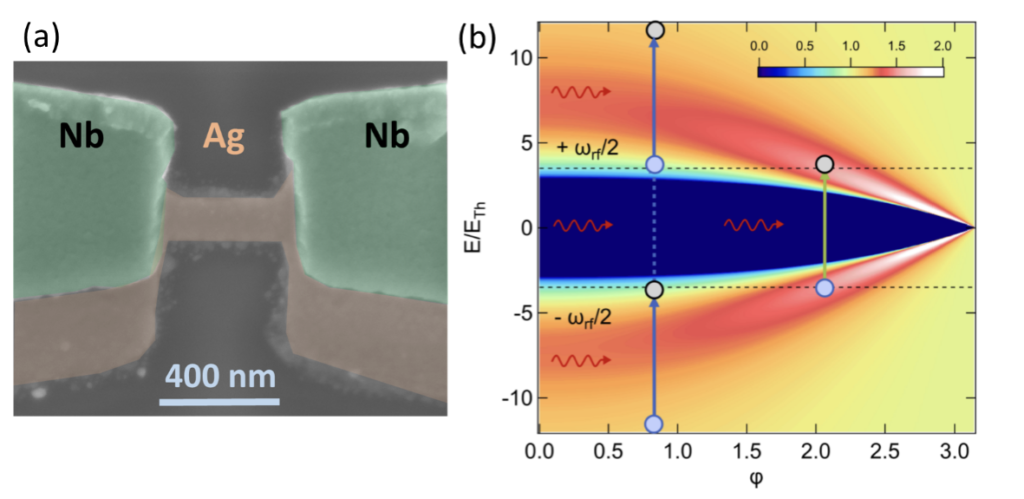Researchers from the LPS and their collaborators have experimentally identified a new regime in Josephson junctions illuminated by microwave radiation. They found that high-frequency and high-power microwaves change the transport across the junction in a different way than the previously known case of low-power microwaves. Josephson junctions occur when a non-superconducting material (a ‘weak link’) separates two superconductors, but still allows the supercurrent to propagate through. Recently, they have been studied as the host of a new kind of qubit (the information carrier for quantum computing), called Andreev qubit, which can be manipulated by illuminating the junction with microwave radiation. This work shows a new effect of radiation on the Josephson junction, and so it has important implications for quantum computing based on Andreev qubits, as well as on the understanding of the nature of quantum transport in strongly driven diffusive Josephson junctions.
The effects of microwave absorption on the transport properties of diffusive Josephson junctions are central to the field of quantum transport. At low temperature, superconductors are unable to absorb microwave radiation energy smaller than the superconductor gap. In a Josephson junction, however, the gap is reduced, and microwave radiation can be absorbed. The well-accepted Eliashberg theory predicts that the microwave absorption only modifies the occupancy of the quasi-particles responsible for the charge transport – the quasiparticles change state, but their underlying energy spectrum remains the same.
The researchers decided to study what happens in the out-of-equilibrium transport regime that occurs when a Josephson junction is strongly driven by a high-power and high-frequency microwave, which is called the non-adiabatic regime. The detection of this regime required very challenging experimental conditions, and to measure it the researchers pioneered a harmonic-resolved ac-Josephson spectroscopy technique which allows to access the harmonic content of the current-phase relation under microwave radiation. What does that mean? First, the researchers applied a DC voltage across a Josephson junction consisting of a silver gap (a normal conductor) between superconducting niobium eletrodes (see figure). This induces an ac current, called the ac Josephson radiation. By varying the DC voltage, they could measure the magnitude and frequency of this ac current, and from it deduce how the current varies with the superconducting phase difference across the gap (the “current-phase relation”). With this approach, they found that when the junction is illuminated with microwaves of sufficiently high frequency and amplitude, higher order harmonics appear in the emitted radiation, at 2, 3, …, n times the base frequency. These harmonics correspond to distortions of the current-phase relation.
Combining the experiments with theoretical work, the researchers were able to reveal and understand this special non-equilibrium state. They found that the incoming microwave radiation changes not only the occupation of quasiparticles (see figure (b))— as in the low-power and frequency case described by the Eliashberg theory — but the energy spectrum of the junction itself. The changes of the energy spectrum then change the current-phase relation, which modifies the harmonics of the ac Josephson radiation.
The researchers now work on applying this new sensitive measurement technique to understand the effect of the electric field on the Josephson junction— a phenomenon that was observed but is still not understood.

Reference
Nonadiabatic dynamics in strongly driven diffusive Josephson junctions
J. Basset, M. Kuzmanovic, P. Virtanen, T. T. Heikkilä, J. Estève, J. Gabelli, C. Strunk, and M. Aprili
Physical Review Research 1, 032009(R) (2019)
doi:10.1103/PhysRevResearch.1.032009
